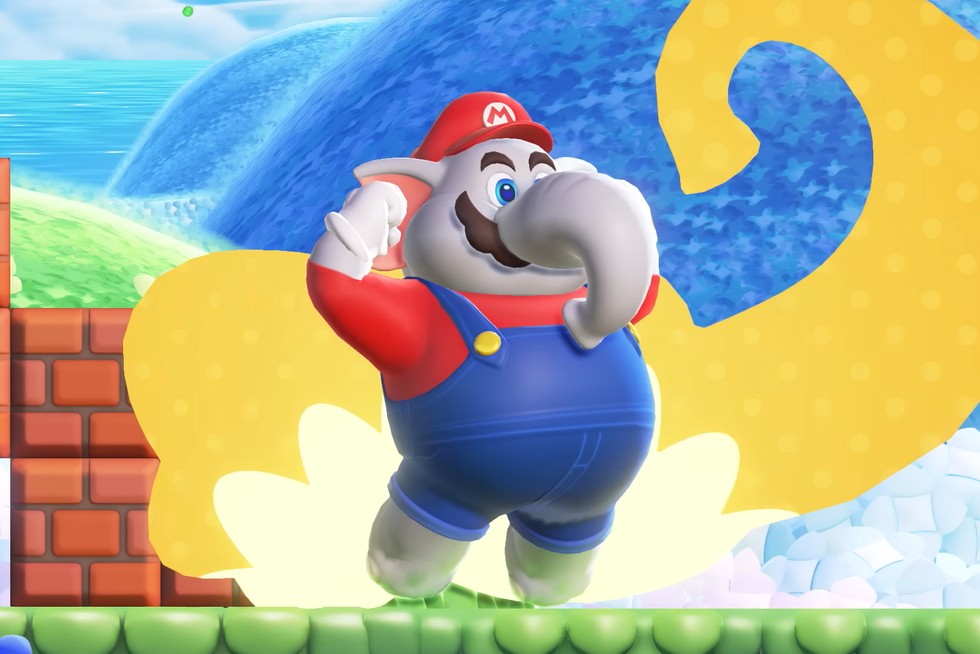Review: Super Mario Bros. Wonder
There is no safer bet in video games than a Mario platformer. Every single game since the original 1985 NES Super Mario Bros. that has featured Mario running and jumping, whether in 2D or 3D, has been at least good, and usually great. Super Mario Bros. Wonder, the third 2D Mario platformer on the Switch (following New Super Mario Bros. U Deluxe and Super Mario Maker 2), is definitely one of the great ones, thanks to a bevy of fresh ideas and Nintendo’s classic drum-tight design. Super Mario Bros. Wonder is an exciting reminder of why Mario is still the face of video games.
Wonder takes place outside of the series’ staple Mushroom Kingdom, instead dropping Mario and friends in the Flower Kingdom, which looks familiar but operates just slightly differently from the world Mario fans are used to. You move through each 2D level the way you would in other recent 2D Mario games – running, jumping, bouncing off walls, and collecting power-ups from question mark blocks – but there’s a playfulness here, with new enemies and unexpected moments designed to subvert decades of expectations.
Super Mario Bros. Wonder’s biggest, most exciting new addition is the Wonder Seeds, collectibles that appear in almost every level that alter the dynamics of the environment, or your character, when picked up. Wonder Seeds are a natural extension of the Mario series’ trademark creativity: a common positive critique of the series is that Nintendo builds levels around concepts rich enough to fuel entire games. Each time you pick up a Wonder Seed, it fundamentally alters the game for the next few minutes – it could be that Mario changes shape, or the game switches to an overhead perspective, or time starts acting up, or even that your enemies break out into song. The “wonder” in the title is an allusion to Alice in Wonderland, and the game is fueled by a similar giddy weirdness to Lewis Carroll’s classic novel. These sections are frequently inventive and exciting, remixing the experience and showing off the depths of the team’s creativity.
The physics in Wonder feel a little reined in and tighter compared to the last few entries, which is to the game’s benefit: I felt like I had a greater degree of control over my movements than was possible in New Super Mario Bros. U Deluxe, and because of that it was rare that deaths or missteps felt like anything other than my own fault.
Super Mario Bros. Wonder is quite easy compared to some other games in the series too – it was rare that I failed Wonder Seed challenges, or died more than a handful of times on any given level. This meant that I rarely found myself getting frustrated as I played, but there’s also something bittersweet about being able to complete levels without dying, nabbing all bonuses along the way, knowing that I’m left with no practical reason to revisit. This is a minor issue, though, and only exists because the levels here are so much fun to play through.
Super Mario Bros. Wonder can be played by up to four players at a time (there’s a variety of characters to choose from), and while it’s not likely to be a big party game, this is a fun way to share the game with family. I enjoyed playing with my partner, but the big surprise is how good the always-online “shared” experience is. If you’re connected online when you enter a level, you can see the “ghosts” of up to three other players around the world who are playing the level at the same time. Right now, within two weeks of launch, levels are heavily populated, which may change over time, but it’s fantastic seeing so many other players.
This is a surprisingly pleasant way of experiencing multiplayer – for the most part you have limited impact on other players, but if you die, you can come back to life by touching another player, and you can watch them for clues about hidden paths within levels. Bringing a player back to life, and then having them return the favour later in the level, is a great feeling, reminding me of the PS3 classic Journey. I’m leaving out a lot here, because this is an extremely feature-rich game. There are unlockable badges, which grant you new powers and will change the way you move through each level; there is variety in the level types, including races, badge challenges, and multiplayer-focused puzzle parks; there’s the fact that Mario can turn into an elephant, and that when you collect that power up he yells “wowie zowie!”. Even the overworld map is more exciting and detailed than it has been in past games.
Super Mario Bros. Wonder is the best 2D Mario platformer in an extremely long time – at least since the SNES. There is no discovery in it that did not delight me, no level that I found to be a slog, no power-up that isn’t fun to explore. Nintendo’s first foray into console development began with a Mario 2D platformer, way back in 1985 – and nearly 40 years later, Mario running and jumping through a new game still feels fresh.
Super Mario Bros. Wonder is available now for Nintendo Switch. A download code was provided for review.
James O’Connor has been reviewing and writing about games since 2008












